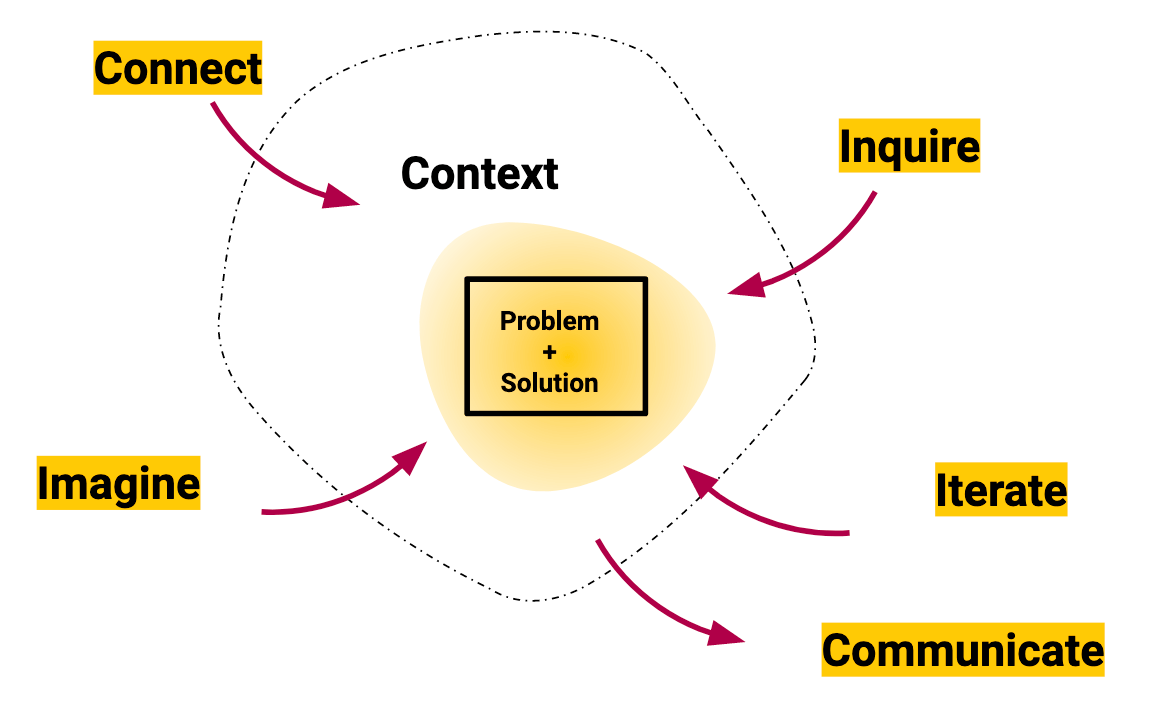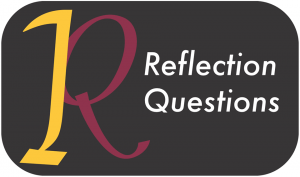Designing learning futures through reflective practice: 2 of 2
By: Punya Mishra and Cristy Guleserian
Design, Principled InnovationThis is the second of two posts on the topic of bringing principled innovation practices to designing learning futures. In this post (by Cristy Guleserian & Punya Mishra) we dive deeper into how these practices of PI connect with our model of design. In particular we seek to answer these reflective questions in the context of our design model.
Our model of PI infused design instantiates the three guiding principles of principled innovation. (For more on the design model see Principled Innovation meets Design: 1 new model and 2 videos and for more on the Principled Innovation framework). In this post we focus specifically on the eight practices of principled innovation through responding to a series of reflective questions.

As we had written in a previous post the questions we raise are not easy to answer but it is essential that we do so, intentionally and deliberately.


Are we considering values that may differ from our own?
In our design model we seek to identify and acknowledge the fundamental valuesof the community we are working with, by distinguishing the values that are important to both the individual community members and the design team. This allows our actions to ensure the solutions honor, appreciate, and reflect the values of the community.
In the design process, we start with connecting to the context with a specific focus on history and experiences, language and culture, and knowledge and beliefs. We constantly return to the context as we design. This is symbolized by context being placed at the very center of the model—specifying its central role in the process. Moreover, our model also emphasizes that the problem/solution spaces are not fixed; they can change through the design process, allowing for reframing the problem to better reflect the values and concerns.

Are we questioning our own biases and how they affect the decisions we make?
We utilize moral and ethical decision-makingthrough engaging empathy and taking a human-centered stance. We seek to view the challenge through the eyes of the humans in the communities we serve. Through the use of a values-informed reflective process we are able to assess possibilities, navigate dilemmas, and make the best possible choice to serve those whose lives and learning will be affected by the decisions we make and the actions we take.
Our design model emphasizes ongoing reflection on not only the context, but also our own beliefs,feelings, and actions. By remaining mindful of our own thoughts and feelings, we can be more aware of how we affect those we work with.

What is the cultural wealth of the people in the community?
We strive to understand culture and context through the use of evidence-based resources, empathy, reflective questioning, and appreciative inquiry. The use of multiple approaches allows us to truly understand the cultural wealth of the community with which we are working. The model is anchored in context, including history and experiences, language and culture, and knowledge and beliefs. We immerse ourselves in the lived and current experiences of the individuals within the community so we can design solutions that are right for their specific needs and learning environments. We also emphasize communication with all stakeholders as a way to engage cultural assets.

Are we soliciting viewpoints different from our own?
The key to supporting a human centered design model is understanding a range of users and their needs. Thus engaging multiple and diverse perspectives is crucial. We seek and champion equitable and inclusive involvement and contribution to the design process by including many different voices who have a variety of lived experiences, beliefs, and backgrounds. We listen to understand, and remain open-minded as we consider how to move forward at any given point of the process.
While designing, we seek input from stakeholders through connecting, inquiring, and communicating. In connecting, we build relationships and strive to understand the perspectives of those in the context. While inquiring, we gather diverse perspectives through methods such as surveying and interviewing. We continually communicate with stakeholders in order to engage multiple perspectives throughout the design process.

What data, resources, and learning are supporting our decisions?
Before and during the design process we continually ask ourselves if we are seeing the entire mosaic while we are designing for one individual piece of the puzzle. We strive to develop habits of an informed systems thinker, ensuring we are gathering evidence-based resources and data to inform how we are thinking about the problem, and appreciate the emerging insights that stem from multiple perspectives. We also step back and look at the larger picture. This allows us to recognize how the individual parts are influenced by their environment and interact to form a complex whole.
In design, we use inquiry to access and integrate data and resources related to the problem/solution space. This can include searching existing literature or conducting original research in regards to the problem/solution space.

Are we taking time to reflect and make adjustments based on our reflections?
It is important that during the design process we continually look at our work through a critical lens, while being kind to ourselves and to others when something isn’t working and we recognize the need to shift directions. By reflecting critically and compassionately, we are able to engage a growth mindset to make meaning of our experiences through contemplation and consideration of our thoughts, feelings and actions. As we develop practical wisdom through our experiences and use it to inform our decisions and actions, both the individuals and the learning environments for which we are designing begin to flourish.
Our design model promotes reflection throughout the design process. Reflection happens in tandem with other actions (such as when we connect, inquire, imagine, iterate, and communicate). Finally, we are sensitive to incoming information and for that reason we continually revisit the problem/solution space refining it throughout the process.

What kinds of unanticipated issues are emerging and how are we responding to them?
Throughout this process there will be trials and tribulations. We’ll need to navigate uncertainty and mitigate consequences. Through observation and reflective questioning we can imagine possible outcomes, or spectacular failures, and respond in a way that changes our course of action before it happens. We navigate the consequences of our actions in a way that fails forward and allows us the space to iterate in a meaningful way, increasing the chance for humane results that reduce the risk of harm to individuals and communities.
The design process emphasizes imagination to anticipate consequences of our work. Designers imagine what might result from proposed actions in order to minimize negative consequences. However, not all outcomes can be anticipated. This is why we create prototypes and test them. In this model, the design is never complete. Designers continually inquire into what is happening in the context and iterate to address problems as they occur. Ongoing communication also aids timely response and adaptations.

Will the solution we are offering better meet the needs of those we aim to serve?
Are we being informed learners and listeners, working collaboratively, and intentionally with and for the community? Are we taking time to pause and reflect on our decisions and actions as we imagine new concepts, catalyze ideas, and form new solutions? If the answer is yes, then we can rest assured we are practicing principled innovation as wedesign creative solutions that will allow both educators and learners to contribute to the future of education and a thriving civil society.
What is unique about this design model is that it is centered on and driven by an understanding of context. It emphasizes the importance of anchoring the design process in the particular needs of the stakeholders. The process cannot occur separate from the context—each act, whether to connect, inquire, imagine, iterate, and communicate happens in reference to the context, resulting in a solution that meets the needs of the community.
